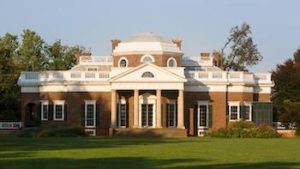
Monticello
*The construction of the Monticello Plantation is affirmed on this date in 1772. This is one of the estimated 46,200 American plantations that existed in 1860.
Located just outside Charlottesville, Virginia, in the Piedmont region, the plantation was originally 5,000 acres and built using slave labor. This was the primary plantation of Thomas Jefferson, the third president of the United States. African people produced extensive tobacco and mixed crop cultivations, later shifting from tobacco cultivation to wheat in response to changing markets. Jefferson located one set of his quarters for his slaves on Mulberry Row, a one-thousand-foot road of slave, service, and industrial structures. Mulberry Row was three hundred feet (100 m) south of Monticello, with the quarters facing the Jefferson mansion.
These cabins were occupied by the enslaved Africans who worked in the mansion or Jefferson's manufacturing ventures and not by those who labored in the fields. At one point, "Jefferson sketched out plans for a row of substantial, dignified neoclassical houses" for Mulberry Row, enslaved blacks and white workers, "having in mind an integrated row of residences." Henry Wiencek argues: "It was no small thing to use architecture to make a visible equality of the races." Jefferson owned Monticello after inheriting land from his father.
Archaeology of the site shows that the rooms of the cabins were much larger in the 1770s than in the 1790s. Earlier houses for enslaved laborers had a two-room plan, one family per room, with a single, shared doorway to the outside. But from the 1790s on, all rooms/families had independent doorways. Most of the cabins are free-standing, single-room structures. At Jefferson's direction, he was buried on the grounds in an area now designated as the Monticello Cemetery. The Monticello Association owns the cemetery, a society of his descendants through Martha Wayles Skelton Jefferson.
He designed the main house using neoclassical design and reworked the design through much of his presidency, integrating numerous ideas of his own. Situated on the summit of an 850-foot mountain, the name Monticello derives from the Italian word "little mountain." Along a prominent lane adjacent to the house, Mulberry Row, the plantation came to include numerous outbuildings for specialized functions, e.g., a nailery; quarters for enslaved Africans who worked in the home; gardens for flowers, produce, and Jefferson's experiments in plant breeding—along with tobacco fields and mixed crops. Cabins for enslaved Africans who worked in the fields were farther from the mansion, literally and figuratively out of Jefferson's sight.
By the time of Jefferson's death, some enslaved families had labored and lived at Monticello for four generations. Jefferson recorded his strategy for employing their children in his Farm Book. Until the age of 10, children served as nurses. When the plantation grew tobacco, children were at a good height to remove and kill tobacco worms from the crops. Once he began growing wheat, fewer people were needed to maintain the crops, so Jefferson established manual trades.
He stated that children "go into the ground or learn trades." When girls were 16, they began spinning and weaving textiles. Boys made nails from ages 10 to 16. In 1794, Jefferson had a dozen boys working at the nailery. While working at the nailery, boys received more food and may have received new clothes if they did a good job. After the nailery, boys became blacksmiths, coopers, carpenters, or house servants. After Jefferson's death, his daughter, Martha Jefferson Randolph, sold the property. In 1834, it was bought by Uriah P. Levy, a commodore in the U.S. Navy, who admired Jefferson and spent his money to preserve the property. His nephew Jefferson Monroe Levy took over the property in 1879 and invested considerable money to restore and preserve it.
In 1923, Monroe Levy sold it to the Thomas Jefferson Foundation (TJF), which operates it as a house museum and educational institution. Due to its architectural and historic significance, the property has been designated a National Historic Landmark. In 1987, Monticello and the nearby University of Virginia, also designed by Jefferson, were designated a UNESCO World Heritage Site. The current nickel, a United States coin, depicts Monticello on its reverse side.
Six families and their descendants were featured in the exhibit Slavery at Jefferson's Monticello: Paradox of Liberty (January to October 2012) at the Smithsonian's National Museum of American History, which also examines Jefferson as an enslaver. Developed as a collaboration between the National Museum of African American History and Culture and Monticello, it is the first exhibit on the National Mall to address these issues. In February 2012, Monticello opened a new outdoor exhibit on its grounds, Landscape of Slavery: Mulberry Row at Monticello, to convey more about the lives of the hundreds of enslaved laborers who lived and worked at the plantation.